This sprouted mung bean sauté is a pleasantly spiced side dish (or main course if you are vegetarian) filled with plenty of protein and healthy nutrients.
It takes just a few minutes to prepare. Once you’ve got the sprouted mung beans ready—and I have full instructions below—all you need to do is add the spices and sauté.
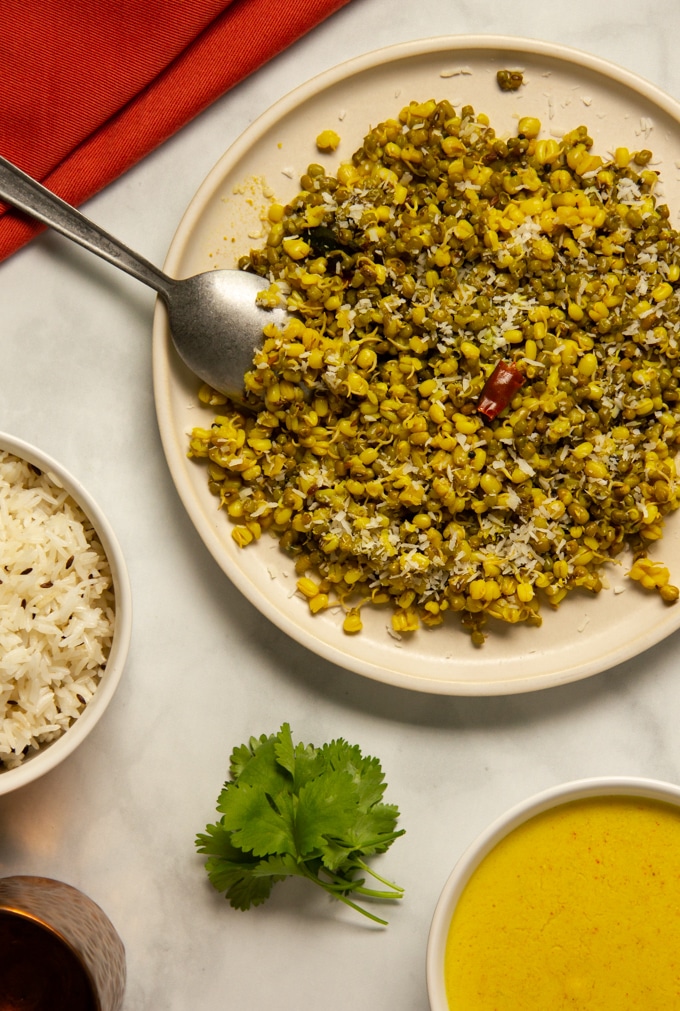
You’ll want to pay close attention during the first couple minutes of cooking, but once you’ve passed this stage, the rest is just simmering the mung beans in water to soften them.
For those of you interested in food culture, this is an authentic Konkani recipe from the Southwestern coastal region of India, which includes the states of Maharashtra, Goa, and Karnataka.
It is a type of “upkari,” which in Hindi refers to a vegetable stir-fry seasoned with coconut.
The coconut adds tropical sweetness to this dish, which you may love. Around my house though, it is entirely optional. I can attest that this sprouted mung bean sauté is still amazing without the coconut.
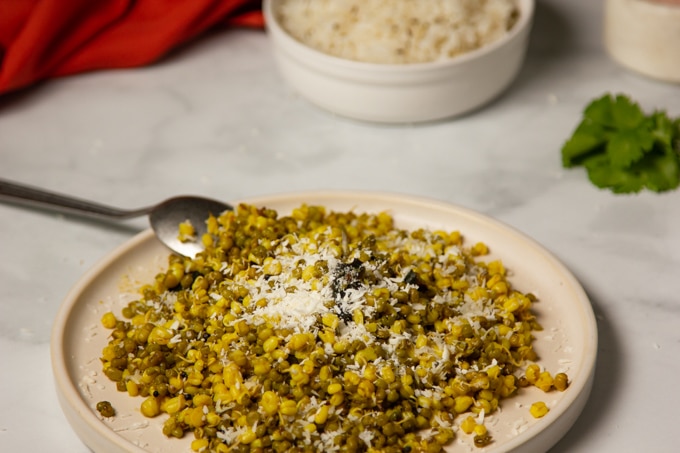
The spices in this recipe are typical of South Indian cooking, which is a favorite of mine, and the traditional cuisine of my husband and in-laws.
[I like it so much, I even have a post on How to Cook Any Vegetable South Indian style.]
The recipe calls for black mustard seeds and asafetida (as well as turmeric and red chili). These are a little uncommon, but totally worth getting to know.
If you don’t have all the spices, you can leave them out, or substitute with garlic or ginger, and still have a tasty and healthy dish.
When paired with basmati rice and a cooked vegetable side dish, you will have a completely satisfying Indian-inspired vegetarian dinner.
I’ve put together a post on my interpretation of a simple Indian dinner menu, and this recipe would be the dal component.
RECOMMENDED FOR YOU:
Simple Indian Dinner Menu: Dal And Basmati Rice
—SEE MORE
Health benefits of sprouts
Sprouting increases the vitamin and enzyme content of seeds. It also predigests nutrients, making them easier for the body to assimilate.
Sprouts also happen to be one of the best foods you can eat in the spring season to support the energy your body needs.
During spring, the body naturally wants to adjust itself from a typical winter diet of heavy, oily foods, to a lighter, sparser diet.
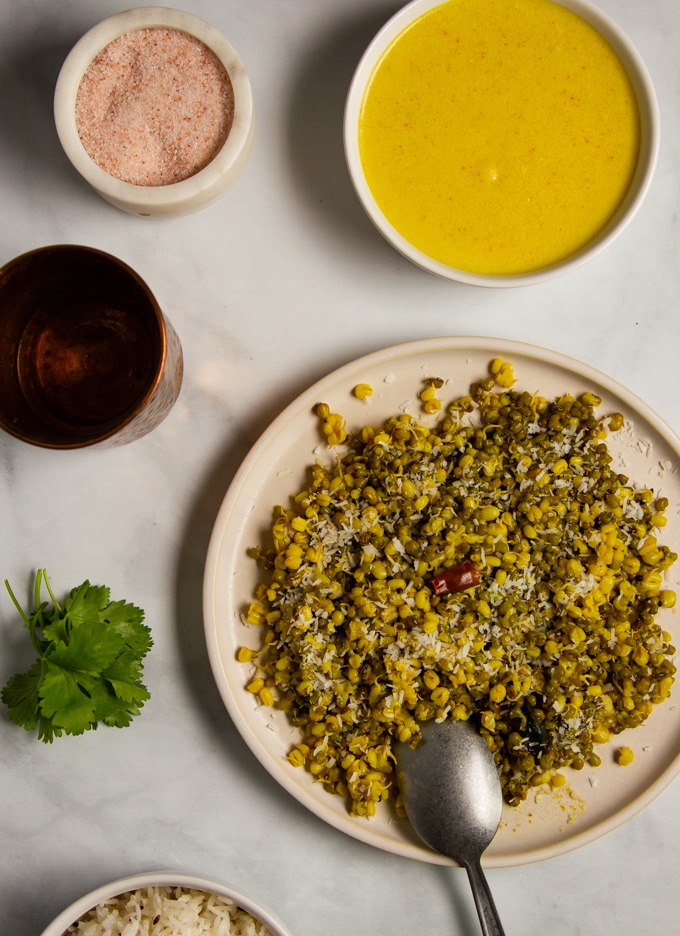
Mung bean sprouts are dry and light, which help to counteract all the wet and damp qualities of a winter diet.
Such qualities are also present in the spring air, so if we aren’t careful with what we consume at this time, we may feel congested and unwell. The goal is to eat foods that contain the opposite qualities from what presents in the environment.
RECOMMENDED FOR YOU:
Mung Bean Sprouts Salad With Green Mango
—SEE MORE
According to “Healing With Whole Foods,” written by my mentor Paul Pitchford, sprouts represent the point of greatest vitality in the life cycle of plants.
Cook sprouts?
For this sprouted mung bean sauté, we are going to cook our sprouts.
Cooking reduces the innate cooling properties of the sprouts, and makes them easier to digest. It also gives us a chance to add flavor to the dish.
Adding gentle spices inspires the taste buds, and makes this a very appealing dish.
You can choose to sauté your sprouted mung beans for as long as you like, but I’ve found that about 15-20 minutes works for me.
At this point, the sprouts are mostly cooked, but still have a bit of bite left to them. Sort of like an al dente pasta.
In this sprouted mung bean sauté recipe, the sprouts are sautéed with black mustard seeds, cumin seeds, red chili, asafetida, turmeric, and coconut flakes.
For those of you who haven’t yet invested in some of these spices, you can leave them out, or you may enjoy adding garlic or ginger as your flavors.
For more information about Indian ingredient substitutions, see this popular post.
For recommendations on where to buy the spices for this recipe, see below.
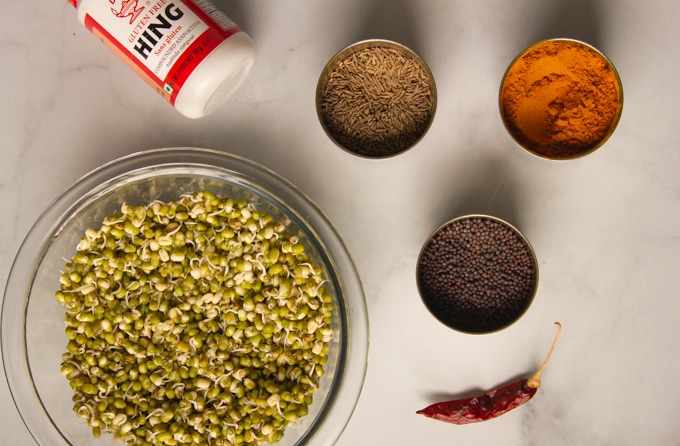
How to sprout mung beans
Sprouted mung beans are really easy to make in as little as two days.
Mung beans are the most common sprouts you can make from seeds, but alfalfa, mustard, sunflower, wheat berry sprouts, and more, are also possible.
To make sprouts, just soak the seeds in a bowl of cold water for 12 hours.
Then strain off the water and leave the sprouts in the bowl.
Leave the bowl covered with a clean tea towel, so the sprouts are in the dark. (It even works if you don’t cover it.)
There is no need for special jars, special lids, special bags or strainers. All you need is a bowl!
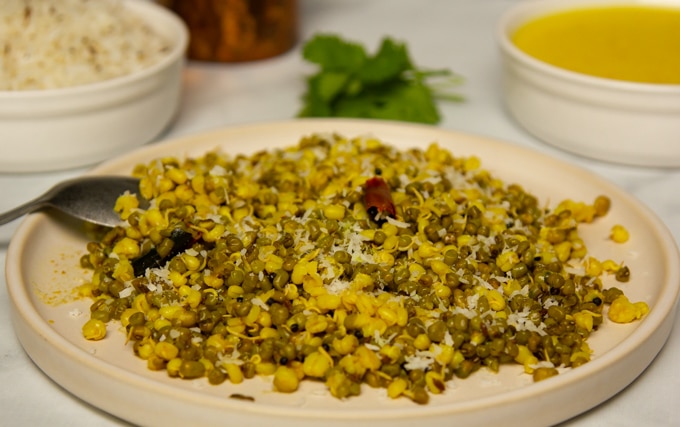
Rinse the sprouts 2 to 3 times a day, draining off the water each time.
Before you know it, you’ll have sprouts.
Now, it is up to you now long you want the tails of new growth to be. The tails will mainly be a textural element for you, since the nutritional quality is the same regardless.
Once the sprouted mung beans are ready, they’ll keep in the fridge for up to five days or longer until you are ready to eat them, or cook them.
RECOMMENDED FOR YOU:
The Best Spring Detox Foods for Mind & Body
—SEE MORE
I hope this demystifies sprouting for you, and inspires you to add sprouts to your diet. 🙂
Make sprouts for your own health, and for greater accord with the seasons.
In addition to today’s recipe for sprouted mung bean sauté, you may also like this companion recipe for mung bean sprouts salad with green mango.
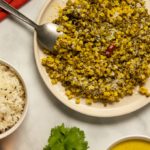
Sprouted Mung Bean Sauté with Coconut (Upkari)
Ingredients
- 2 cups mung bean sprouts, (see notes)
- 2 teaspoons vegetable oil
- ½ teaspoon black mustard seeds
- ½ teaspoon cumin seeds
- 1 dry whole red chili, broken into 2 to 3 pieces
- pinch asafetida, (optional)
- ¼ teaspoon turmeric powder
- pinch Himalayan pink salt, to taste
- 1 cup water
- 2 tablespoons desiccated coconut flakes (unsweetened)
Instructions
Make mung bean sprouts
- Soak ½ cup dried mung beans in a bowl of cold water for 12 hours. Drain off the water and leave the sprouts in the bowl. Rinse the sprouts 2 to 3 times a day, draining off the water each time. Leave the bowl covered with a clean tea towel, so the sprouts are in the dark. Within 24 hours, you’ll have sprouts. They’ll keep in the fridge for a few days until you are ready to use them.
Make the mung bean sprouts sauté
- Heat vegetable oil in a saucepan on medium heat. Add black mustard seeds and cook until they start to pop. Add cumin seeds, red chili, and optional asafetida, and sauté until cumin seeds are golden brown. Add mung beans, turmeric powder, and water, and cover.
- Simmer for 15 minutes or more, until the mung beans are softened to your preference. Add more water if necessary so it doesn’t dry out.
- Add the coconut flakes and cook for about 1 minute, just before serving.
Notes
Nutrition
If you liked this post, please share it with your friends on social media, or leave a comment below.
For more Buttered Veg lifestyle content, follow me on Pinterest, Facebook, Instagram, and Twitter.





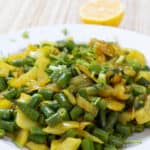


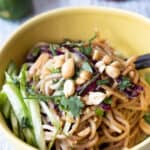

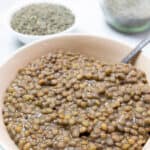
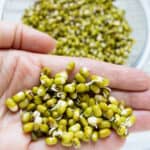
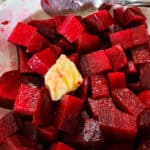

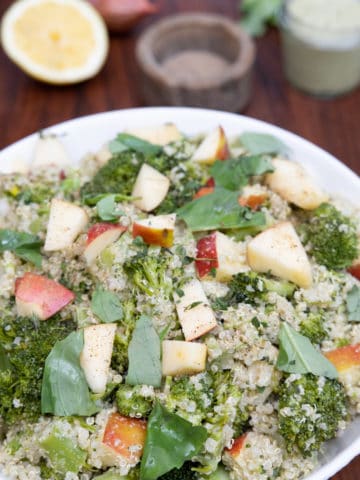

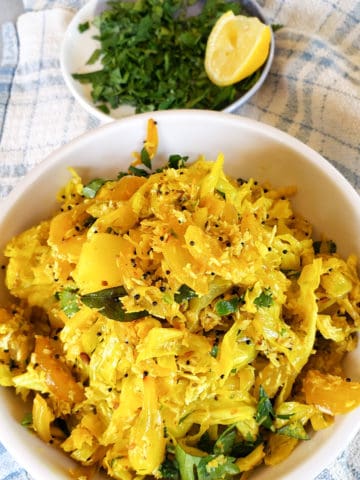
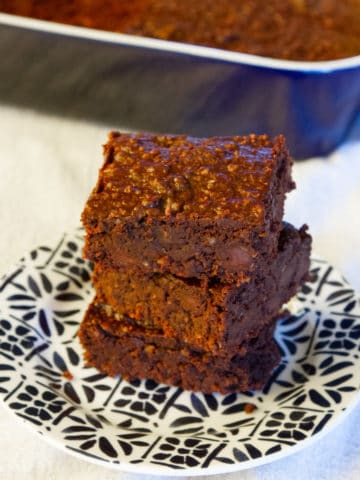
Michelle
I just recently tried sprouting mung beans and have been looking for recipes to try. I cannot wait to try this one! Thanks for the recipe. Question though for the coconut flakes, do you use sweetened or unsweetened?
Andrea
Hi Michelle, Fantastic! I always purchase unsweetened. This way you have freedom to add sugar when needed, and not have it when you don't need it!
— Enjoy this healthy recipe,
Andrea
Michelle
Thanks for clarifying that and I’ve now made this multiple times since. I absolutely love it. So much so that I’m trying to figure out what else I can serve it with. Thank you for the recipe!
Ricardo
Hi Andrea, Thank you for your recipe. I am a beginner at plant based cooking and so have been watching for how I can get all of the protein i need from plants. Good News ! I noticed that you are dividing 2 cups of sprouted mung beans (36 grams of protein) into 3 servings, which = 12 grams of protein/serving which is considerably more than the 3 grams of protein you have listed in your nutrition notes. It is a great protein-rich recipe! Thanks again !
Andrea
Hi Ricardo,
Thanks for your diligence in double-checking the nutrition facts. My API service isn't perfect. I appreciate that you have pointed this out for everyone else now. How did you enjoy the recipe? —Andrea
Amaury
I just made it. I didn't grow my own sprouts, I might give it a try. Sometime back I had found a package of dry mung bean sprouts at Target, so I used that and some fresh long tail mung bean sprouts I picked at the grocery store in this recipe. I also added curry leaves. It came out great. I paired it with a fresh pot of ghee rice. I'm going to post my photo on IG and tag you. Can't wait to try mung bean sprouts salad with green mango.
Any suggestions for papaya?
Andrea
Hi there Amaury, I saw your picture, and it looked wonderful—and with ghee rice is a beautiful combination. I love the idea of the papaya instead of the green mango, especially if you can find one that isn't too ripe. Green papaya is just a thing as green mango. Both were a bit of a revelation to me at first. However, I enjoy sweet taste, so even if your papaya is ripe you can use it. And for a simple but tasty addition to ripe papaya, try grated some fresh ginger with a squeeze of lime. That will be really refreshing on a hot day. 🙂 Take care. Andrea
Sarita
Too much asafoetida! It’s unhealthy! A pinch is all that is needed...
Andrea
Hi Sarita, Thank you for pointing this out. I agree with you, and I adjusted the recipe. I admit that I am quite a fan of asafetida, but I think this was my mistake for sure as 1/2 teaspoon would be too much. Recently I got the pure Hing, and it is even more powerful. A tiny pinch can be too much.